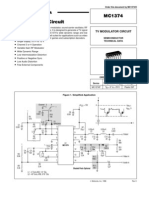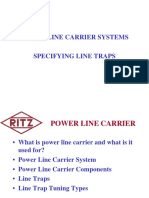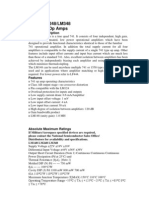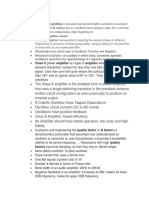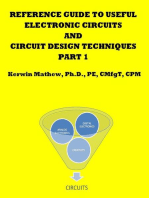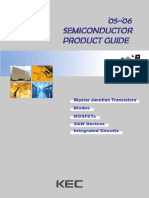Presentation (English)
Presentation (English)
Uploaded by
kagore_bCopyright:
Available Formats
Presentation (English)
Presentation (English)
Uploaded by
kagore_bCopyright
Available Formats
Share this document
Did you find this document useful?
Is this content inappropriate?
Copyright:
Available Formats
Presentation (English)
Presentation (English)
Uploaded by
kagore_bCopyright:
Available Formats
SENDER A.M.
Transmitters
SENDER S.A.
SENDER
SENDER S.A.
Company was created in 1997 by a group of engineers and
technitians with long experience in Solid state A.M.
Transmitters.
Located in Santiago Chile, with 25 employes.
40% of them are shareholders.
Main activity: Design and manufacturing of A.M. transmitters,
antenna tuning units, duplexers and triplexers.
First transmitter in operation Nov 1997.
Transmitters sold up to now:127 from 1 KW to 12.5 KW.
SENDER
Product Line
AM 1500 SS 1.5 KW/1.1 KW, single phase / 2 power
amplifiers
AM 3000 SS 2.25 KW/3KW, single phase or 3 phase / 4
power amplifiers.
AM 7500 SS 5.5 KW/ 7.5 KW, 3 phase or single phase / 7
power amplifiers.
AM 15000 SS 11 KW/13 KW,3 phase / 14 power amplifiers
AM 25000 SS 22 KW/26KW, 3 phase / 28 power amplifiers
A.T.Us for 1.5 KW, 3 KW,7.5 KW, 13 KW and 26 KW
SENDER
Product highlights
Solid State. Modular / redundant
architecture
High efficiency. PWM & class D R.F.
amplifiers
Hot plug in power amplifiers with Mosfets.
Simple design with standard components.
Totally rustproof cabinet made of iridated
aluminum with stainless steel hardware.
Excellent specs and audio quality.
Outstanding factory support.
Very competitive price.
SENDER
Basic specifications
Frequency range: .53 MHZ to 1.7 MHZ.
Input voltage: 110V or 220 V single phase, 220V or 380V 3 ph
+or - 10%. Line frequency 47HZ to 63 HZ.
Efficiency: 75% or better for single phase transmitters,
80% or better for 3 phase transmitters.
Frequency response: Better than +or- 1 dB 30 Hz to 10 KHZ.
Distortion: Less than 1% at nominal power and 90% modulation.
Harmonics and spurious:- 73 dB or better for AM 1500 SS,
- 80 dB or better for other models.
SENDER
Frequency stability:+- 5 Hz.
Output impedance: 50 Ohm
Dimentions and weigths:
AM 1500 SS W=44 cm,H=62.5cm
D=60 cM , 100 Kg.
AM 3000 SS W=44 cm,H=65.5cm
D=60 cM , 160 Kg.
AM 15000 SS W=80 cm,H=181cm
D=81 cM , 500 Kg.
SENDER
Standard features:
2 power level with independient adjustment
and modulation autotracking.
Start, stop,power level selection and power
level adjustment remotely controled.
Automatic alarm reset.
Positive and negative limiter.
SENDER
Basic block diagram
Synth
PWM
Combiner
An
A2
A1
Output
Filter
Control
PWR
Supply
Out
SENDER
Relationship with
RICHARDSON ELECTRONICS
Exclusive representation for Asia and other specific countries.
Joint project to manufacture transmitters in U.S.A.
Sender sells Omnicast F.M. Transmitters in Latin America.
Excellent level of personal contacts .
SENDER
Near future projects
FCC type acceptance.
Frequency agile 1.5 KW transmitter.
IBOC compatibility.
Inboard audio processor and modulation monitor.
Higher power amplifiers
SENDER
Reliability in A.M. stations
SENDER
Introduction
Harmonic set of:
Transmitter
Radiating system
Energy System
Auxiliary Equipment
Station Concept
SENDER
Experience with stations using Solid
State A.M. Transmitters
Very high reliability if precautions
related with the following topics are
considered:
Antenna discharges
A.C. Source transients and discharges
A.C. Source voltage limits
Load stability
Interference from nearby stations
Reliability is reduced in unprotected stations
SENDER
A.C.
Basic elements of a station
GROUND PLANE
ATU
TX
STL
RX
RF
Audio &
Rem. Ctrl.
T.P.
H.V
TRANSF.
DISTR.
BOARD
ANTENNA
SENDER
TRANSMITTER BASIC BLOCKS
POWER SUPPLY
PWM MODULATOR
R.F. DRIVER
CLASS D or E
R.F. OUTPUT FILTER
CONTROL,PROTECTIONS,SIGNALING
EXTERNAL INTERFACE
SENDER
PWM MODULATOR
GENERATES D.C + A.C. VOLTAGE FOR
THE R.F. AMP.
SWITCHING DEVICE, HIGH EFFICIENCY
A FILTER IS NEEDED TO ELIMINATE
SWITCHING FREQUENCIES
CONMUTATION FREQUENCY IS 72 KHZ.
SENDER
PWM (PULSE WIDTH MODULATION)
SIMPLIFIED DIAGRAM:
D.C. SUPPLY Switch
(Mosfet)
PWM FILTER LOAD
R.F.
AMPLIFIER
SENDER
PWM BASIC OPERATION
Filtered output voltage PWM waveform
1)
2)
3)
4)
S
V RL
Between 1) y 4) duty cycle is increased
Mean voltage in the load increases proportionally
A filter is required to remove high frequency components
F = 72 kHz
SENDER
PWM Frequency spectrum
72 kHz 144 kHz
D.C Component
Audio
Amplitude
Frecuency
PWM 0
SENDER
PWM Frequency spectrum
72 kHz
144 kHz
D.C. component
Audio
Amplitude
Frecuency
72 KHZ components out of phase
PWM 180
SENDER
PWM filter diagram
SENDER
PWM filter frequency response
SENDER
PWM filter response sensibility
to load changes
Rload +/- 15%
SENDER
Load change consequences
With reduced load (Rload< Rnominal)
transmitter will produce high frequency
submodulation
With increased load (Rload>Rnominal)
transmitter will show high frequency
overmodulation
Distorsion will increase if filter is not
propperly loaded.
SENDER
Modulated class D R.F. Amplifier.
T1
T2
RL
T3
T4
PWM filter
+V
SENDER
Class D r.f. Amplifier diagram
SENDER
Class D Bridge parasitic
elements
RL
V+
Cds
Cgd
Cgs
Cds
Cgd
Cgs
Ciss = Cgs + Cgd Crss = Cgd Coss = Cds + Cgd
Cds
Cgd
Cgs
Cds
Cgd
Cgs
SENDER
Mosfets drive
T1
T2
RL
T3
V+
Vgs(thr)
Vgs peak = 13V
Dead
time
Vgs
time
T4
SENDER
R.F. drive circuit
SCgs
Drive signal
Ls Cs
Lp
Ls and Cs series resonant
Lp paralel resonant with mosfet input
capacitance (Partially)
MOSFET drive
SENDER
Class D bridge current paths
T1
T2
RL
T3
T4
V+
T1
T2
RL
T3
T4
V+
SENDER
Class D bridge undisered current
paths.
T1
T2
RL
T3
T4
V+
T1
T2
RL
T3
T4
V+
SENDER
Class D Amplifier basics.
Low impedance driver required for:
Fast switching
Low Vgs modulation by Crss
Tuned load to produce sinusoidal
current
High efficiency (>95 %)
Duty cycle should be < 0.5
Avoid transversal currents
Coss charge and discharge through Rl
SENDER
Class D R.F. Amp typical
waveforms.
SENDER
MOSFET characteristics
No secondary breakdown
positive temperature coeff. Of Rdson
(Simplify parallel operation)
Voltage controled device (Vgs)
Driver impedance dependent switching
times.
Intrinsic antiparallel diode
SENDER
IRFP350 MOSFET
Rdson = 0.3 ohms
Vdss = 400 Vdc
Vgs = +/- 20 Vmax Vth = 3 V Vsat = 9 V
Id = 16 A @ Tc=25C 10 A @ Tc=100C
Idmax = 64 A
Capacitance @ f=1MHz, Vds=25V , Vgs=0V
Ciss = 2600 pF (2400 pF for Vds>40V)
Coss = 660 pF (200 pF for Vds>40V)
Crss = 250 pF (50 pF for Vds>40V)
SENDER
Class D amplifier example
SENDER
SENDER
Class D Simulation
(1/2 bridge,Vmax<400x.75/2.5)
Cicuit data
Vdc = 110 V
F = 1600 kHz
d = 0.43
Transistor IRFP350
Rdson = 0.3 ohms
Ton = 16 ns
Toff = 40 ns
Coss = 200 pF
L2 = 7.04 uH
C2 = 1.55 nF
Operational data
RL = 15 ohms
Po = 132.36 W
h = 97.93 %
Transistor stresses
Vmax = 110.81 V
Imax = 4.12 A
Pdis = 0.70 W x2
(1.4 Wtotal)
*Simulated with HB plusfrom Design Automation
SENDER
Class E Amplifier diagram
SENDER
Class E amplifier example
SENDER
Class E amplifier basics.
R.F.Choke large enough to produce
constant current
High Q series resonant circuit to
produce sinusoidal current
Vds y dVds/dt =0 prior to starting
conduction
High efficiency (>95%)
if special high voltage transistors with low
Rdson are used
SENDER
Clase E Waveforms
SENDER
Clase E Simulation
(Vmax<400x.75/2.5)
Circuit Data
Vdc = 33 V
F = 1600 kHz
d = 0.48
Transistor IRFP350
Rdson = 0.3 ohms
Ton = 16 ns
Toff = 40 ns
Coss = 200 pF
L1=12.3uH L2=3.7uH
C1= 4.1nF C2=4.9nF
Operational Data
RL = 7.3 ohms
Po = 125.27 W
h = 90.53 %
Transistor stresses
Vmax = 118.79 V
Imax = 9.84 A
Pdis = 6.55 W x2
(13.1 Wtotal)
*Simulated with HEPA Plus from Design Automation
SENDER
Passband Output filter
Reduce R.F. Harmonics
High third harmonic att > 80 dB
Medium second harmonic att. > 40 dB
Higher harmonics att > 70 dB
Permits impedance matching between
amplifier and load.
Atenuates low frequency components
(Lightning protection)
SENDER
Output filter
Design oriented to protect R.F.amplifier
Low frequency attenuation
Inductor input
Strategically located sensors:
Spark Gap Transient suppressor
SWR Overpower
Overcurrent Phase
Input transient suppressor(Active or pasive)
SENDER
Output filter diagram
SENDER
Output filter frequency response
SENDER
Real and imaginary part of filter
input impedance
SENDER
Protections integrated in the
output filter
S E N D E R
SENDER
SENDER
Posible Transmitter Agresions
Antenna
Impedance change and discharges
A.C. Supply
Voltage variation and transients
Program signal
Level variations and transients
Ground
Transfered potentials and high ground
currents
SENDER
Antenna related problems
Impedance change
Low heigth antennas are particularly
unstable
Restricted bandwidth
Interference from other stations
Discharges
SENDER
Short antenna example
60 m tower operating at 700 kHz
ZL = 8 - j160
Q = 20
Electrical length = 50.4
SENDER
Type T -90 Standard A.T.U.
4.55uH
j20
40.9uH
j180
ZL
8-j160
11.37nF
-j20
Zin
50+j0
SENDER
A.T.U.Sensibility to antenna
impedance changes
Change in XL (+/- 10 ohm=6%)
if ZL=8-j150 Zin=19.5-j24.4 SWR=3.26
if ZL=8-j160 Zin=50+J0 SWR=1
if Zl=8-J170 Zin=19.5+j24.4 SWR=3.26
Change in RL ( +/- 1 ohm =12.5%)
if ZL=7-j160 Zin=57.1+j0 SWR=1.14
if ZL=9-j160 Zin=44.4+j0 SWR=1.14
RL and XL simultaneous variation
if ZL=7-j150 Zin=18.8-j26.8 SWR=3.52
if ZL=7-j170 Zin=18.8+j26.8 SWR=3.52
if ZL=9-j150 Zin=19.9-j22 SWR=3.10
if ZL=9-j170 Zin=19.9+j22 SWR=3.10
SENDER
Complex A.T.U. (dual T)
j5 j145
ZL
8-j160
j37
Zin
50+j0
j50.5
-j92.5
-j44.9
Variations in XL
if ZL=8-j150 Zin=50+j62.5 SWR=3.26
if ZL=8-j160 Zin=50+j0 SWR=1.00
if ZL=8-j170 Zin=50-j62.5 SWR=3.26
Note: SWR of 8+/-j10 refered to a 8+j0 is 3.26
!
20
-20
20-J13
SENDER
Load ladder
RF amplifiers
Zn
Z1
Extreme values for SWR 1:1.5, refered to 50 Ohm, are:
33.3+j0 75.0+j0
50-j20.4 50+j20.4
1
n
combiner
filter
A.T.U.
Antenna
50 Ohm
15 Ohm
SENDER
Load variation effects
Class D amplifier
Load VSWR
(%)
P (1/2
bridge)
Vmax (V) Imax (A)
15 1 97.93 132.36 110.81 4.12
15-j6.1 1.5 96.55 151.92 109.80 57.77
15+j6.1 1.5 97.83 93.00 110.83 3.44
22.5 1.5 98.47 96.08 110.02 13.89
10.0 1.5 96.94 165.02 110.84 5.66
SENDER
A.T.U. And amplifier stresses
A)ZL=50-J62.5
Eff=93.5% Po=4.5W Ip=15.5A
B) ZL=50+J62.5
Eff=90.9% Po=2.02W Ip=1A
C) ZL=19.5+J24.4
Eff=84% Po=44W Ip=105A
D)ZL=19.5+J24.4
Eff=93.8% Po=395W Ip=73.7A
90
20+20
SENDER
Class D waveforms
Ro=15 VSWR=1:1
SENDER
Class D waveforms
Ro=15-j6.1 VSWR=1:1.5
SENDER
Class D waveforms
Ro=15+j6.1 VSWR=1:1.5
SENDER
Class D waveforms
Ro=22.5 VSWR=1:1.5
SENDER
Class D waveforms
Ro=10.0 VSWR=1:1.5
SENDER
Atmospheric discharges
At the antenna
In A.C.lines
In telephone lines
Characteristics
Imax: 200 kA Itypical: 10 a 20 kA
dI/dT typical: 10 kA/useg
Risetime: 2 useg Decay time:40 useg to 50%
SENDER
Criteria to minimize damages
Disipators
Avoid charge acumulation using sharp
points
or active systems
Well designed grounding system
Low impedance direct paths
High impedance undesired paths
Radial equipotential conections
Antenna and ground conection closely
located at TX
SENDER
Discharge probability function
N = 15 L (CH+h)
2
10
-6
N = Discharges per year
L = Ceraunic level (N of days per year when thunderstorms
are heared)
C = Site topographic index (0 to 0,3)
H = Site mean heigth above surroundings (1 to2 km)
h = Antenna heigth
Example: C=0.1 L=50 H=100m h=120m
N = 12.7 discharges per year.
SENDER
Discharge current
circulation
1
14
10
7
2
5
3
8
6
11
4
13
12
15
9
16
17
1. Strike
2. Antenna
3. Discharge through the antenna
4. Guy
5. Isolator
6. Spark gap
7. Ground rod
8. Base insulator
9. Cnecting Loop
11. A.T.U. isolator
12. A.T.U.
13. Ferrite core
14. Coaxial cable
15. Discharge current in caxial cable
16. A.T.U. Spark gap
17. Disipator
SENDER
Equipment Instalation
A.C. Line transient protector
Panelboard
Coaxial cable
Building ground
Ferrite
toroids
Transmitter A.C. line
A.C. mains
Reference ground
Ground to
auxiliary
equipment
SENDER
Ground system equivalent circuit
SENDER
Discharge voltages and currents
SENDER
Interference
1.- Intermodulation products are generated
2.- SWR protection is desensitized
3.- Dangerous voltages at the R.F. Amplifier and
output filter maybe generated.
SENDER
Transmitter Protections
A.C.input
Overload
Short cicuit
Transients
Overvoltage
Undervoltage
Assimetry
D.C.supply
Overload
Transients
Failure
R.F.
Overcurrent
SWR
Phase
overpower
Transients
Internal
R.F. Drive
Temperature
PLL
SENDER
Factory tests to ensure transmitter
reliability
Power amplifiers
Long time operation at 150% modulation
Output
Open cicuit
Short circuit
Simulated lightning strike
SWR
A.C. input
Phase failure
Simulated transient
Voltage variationSENDER
SENDER
Conclusions
Transmitter intrinsic reliability
Power stages regimes much lower than devices
limits
Simple low power stages with low number of
components
Rational protections adjustment
Reliability in a transmitting sytem is a function of:
SENDER
Conclusions
High quality station engineering
A.C. Transient protection
Antenna discharges protection
Well dimentioned and coordinated grounds.
Stable radiating sysytem.
Interference filtering
Coordination with the manufacturer
SENDER
Recomended instrumentation for
test and adjustment
1.- To measure resonance:
1.1 R.F.Generator
1.2 Oscilloscope or spectrum analyzer
2.- To measure R.F.impedance:
2.1 R.F. bridge (General Radio 1609 or
Delta OIB-3)
2.2 R.F. generator (Delta RG3-A or
similar)
2.2 Spectrum analyzer (HP 8553B or
similar) or detector included in RG3-A
SENDER
3.- To measure power:
3.1 R.F. Dummy load,non inductive or with
a tuning network to adjust it to 50+J0 Ohm.
3.2 R.F. Ammeter (Delta TC-1 or similar)
or R.F. Wattmeter
4.- To measure frequency response and distortion:
4.1 General purpose oscilloscope, 2 channel
4.2 Audio analyzer (Audio precision Portable
One or similar)
4.3 Modulation monitor (H.P. 8901 A or B , Belar
AMM3, TFT 923 A.M. or similar.)
2.3 An H.P. vector impedance meter
may be used instead of 2.1,2.2 and 2.3
SENDER
5.- To measure spectrum.-
5.1 Spectrum analyzer 100KHZ.to 50 MHZ or more
TEK 2711, H.P. 8553B plus display unit or similar).
5.2 R.F. atenuator.
5.3 OPTIONAL. Notch filter to remove the carrier
frequency and avoid intermodulation
6.- To check efficiency.
6.1 A.C. Analyzer.(To measure A.C. voltage, current,
power and power factor
SENDER
7.- To measure transmitter carrier frequency.
7.1 Digital frequency meter up to 10 MHZ.
Or higher frequency, time base 1 P.P.M. or less.
8.- To measure temperature.
8.1 Infrared temperature measuring unit with suitable
digital multitester. (Fluke).
9.- For general voltage and current measurements:
9.1 True RMS digital multimeter, suitable to operate
in high R.F. fields. (Our best experience is with Fuke
Digital multimeters.)
SENDER
10.- For long run test.
10.1 USASI Noise generator. (Delta SNG-1).
SENDER
SENDER
Pablo Phillips D.
Agosto 1999
SENDER
You might also like
- SENDER A.M. TransmittersDocument80 pagesSENDER A.M. TransmittersClaudinei FigueiraNo ratings yet
- AM Generation: High Level Low LevelDocument13 pagesAM Generation: High Level Low Levelsubdh neupaneNo ratings yet
- Part I: Amplifier FundamentalsDocument29 pagesPart I: Amplifier FundamentalsbinukirubaNo ratings yet
- RF Power Amplifier Design (Meyer Arthaber, Wien TU Slides)Document27 pagesRF Power Amplifier Design (Meyer Arthaber, Wien TU Slides)ryanketrowNo ratings yet
- Very High Performance Image Rejecting Direct Conversion ReceiversDocument37 pagesVery High Performance Image Rejecting Direct Conversion ReceiversmonDY100% (1)
- Radio Aspects, Cell Sites and Antenna Subsystem: Lab. Antena Jurusan Teknik Elektro StttelkomDocument28 pagesRadio Aspects, Cell Sites and Antenna Subsystem: Lab. Antena Jurusan Teknik Elektro StttelkomMade BienNo ratings yet
- EE 04 Electronics Communication NotesDocument17 pagesEE 04 Electronics Communication Notescarloacma473No ratings yet
- Lab Manual 2Document92 pagesLab Manual 2Joyce GeorgeNo ratings yet
- Signals and SystemsDocument59 pagesSignals and SystemsArvind BhosaleNo ratings yet
- Lec 1 Introduction Frequencty ResponseDocument61 pagesLec 1 Introduction Frequencty ResponseAli AhmadNo ratings yet
- NDB SA-25, SA-50, & SA-100 Operation ManualDocument48 pagesNDB SA-25, SA-50, & SA-100 Operation ManualFazz Yaakub100% (2)
- Analog Circuit Testing: - Test Problems - Basic Components / Parameters - Test MethodsDocument132 pagesAnalog Circuit Testing: - Test Problems - Basic Components / Parameters - Test MethodsSri SaiNo ratings yet
- Eet 223 (1) Analog Electronics JagjeetDocument79 pagesEet 223 (1) Analog Electronics JagjeetMahima ArrawatiaNo ratings yet
- Lecture - 1 Power AmplifiersDocument75 pagesLecture - 1 Power AmplifiersMadhumitha VetrivelNo ratings yet
- KPRay LecDocument45 pagesKPRay LecshivaspyNo ratings yet
- Circuits Lab Program Manual (1-6 Exp)Document46 pagesCircuits Lab Program Manual (1-6 Exp)727722euec122No ratings yet
- Electronic Circuits: Engr. Denver G. MagtibayDocument106 pagesElectronic Circuits: Engr. Denver G. MagtibayRealyn Macatangay100% (2)
- Class D Tutorial 2Document74 pagesClass D Tutorial 2Gerardo Mendez CamarilloNo ratings yet
- Radar Transmitter Overview Tube and Solid StateDocument38 pagesRadar Transmitter Overview Tube and Solid Statesameer_msbNo ratings yet
- DPS-10 SMDocument28 pagesDPS-10 SMJose Luis Moran ChinchayNo ratings yet
- Power AmplifierDocument23 pagesPower Amplifierdattaajay49No ratings yet
- Team Luger: Laser Guided Energy ReceiverDocument34 pagesTeam Luger: Laser Guided Energy ReceivertecnicodeprimeraNo ratings yet
- Analog Electronics Circuit: Unit 1 Single and Multistage AmplifiersDocument87 pagesAnalog Electronics Circuit: Unit 1 Single and Multistage AmplifiersTripti AgarwalNo ratings yet
- FM ReceiverDocument26 pagesFM ReceiverVs Varun Sardana100% (4)
- Electronics Circuits For Communications@Chapter 2Document104 pagesElectronics Circuits For Communications@Chapter 2Lee Ritz100% (1)
- ClasssA AmpDocument7 pagesClasssA AmpRamNo ratings yet
- Iraudamp1 - High Power Class D Audio Power Amplifier Using IR2011SDocument24 pagesIraudamp1 - High Power Class D Audio Power Amplifier Using IR2011SChuYurNo ratings yet
- Presentation Microwave Transmitter and Receiver-1Document22 pagesPresentation Microwave Transmitter and Receiver-1Subrata Maiti100% (1)
- Transceiver ArchitecturesDocument23 pagesTransceiver ArchitecturesEnricoLia100% (1)
- CT LMDocument44 pagesCT LMNikhil KolheNo ratings yet
- Charoy PDFDocument25 pagesCharoy PDFAhmed58seribegawanNo ratings yet
- The Ovation E-Amp: A 180 W High-Fidelity Audio Power AmplifierDocument61 pagesThe Ovation E-Amp: A 180 W High-Fidelity Audio Power AmplifierNini Farribas100% (1)
- Lesson 2-FM Transmitter TerbaruDocument52 pagesLesson 2-FM Transmitter TerbaruRasyid To HomeworkNo ratings yet
- RF BasicsDocument60 pagesRF BasicsHasan ZahidNo ratings yet
- SR510 MDocument73 pagesSR510 McampuspointNo ratings yet
- High Power Class D Audio Power Amplifier Using IR2011SDocument22 pagesHigh Power Class D Audio Power Amplifier Using IR2011SAbubakar SidikNo ratings yet
- AM Transmitter PaperDocument6 pagesAM Transmitter PaperCARLOS PRUDENCIO DE GRACIANo ratings yet
- Project Report #3Document9 pagesProject Report #3Muhammad AnasNo ratings yet
- 665 PA - NotesDocument31 pages665 PA - Notesthap_dinhNo ratings yet
- TV Modulator Circuit: Semiconductor Technical DataDocument10 pagesTV Modulator Circuit: Semiconductor Technical Databanduat83No ratings yet
- Class A Power Amplifier (MOSFET)Document5 pagesClass A Power Amplifier (MOSFET)Tom ShibuNo ratings yet
- RC Phase Shift Oscillator and RC Coupled Ce Amplifier - Lab ExperimentDocument8 pagesRC Phase Shift Oscillator and RC Coupled Ce Amplifier - Lab ExperimentMani Bharathi100% (1)
- AmplifikatoretDocument124 pagesAmplifikatoretXha RuliNo ratings yet
- SMPS Teune Mee PDFDocument71 pagesSMPS Teune Mee PDFbacuoc.nguyen356No ratings yet
- Power Line CarrierDocument88 pagesPower Line Carriermamontoy100% (1)
- LA24Document2 pagesLA24henrycervantes4No ratings yet
- 60w SubwoferDocument3 pages60w Subwoferghimpe--No ratings yet
- QAMP20Document20 pagesQAMP20sankopubNo ratings yet
- TDA1072ADocument20 pagesTDA1072AUbiracy ZanetiNo ratings yet
- Transceivers For Millimeter WavesDocument35 pagesTransceivers For Millimeter WavesmpoornishwarNo ratings yet
- Electronics Circuits IIDocument50 pagesElectronics Circuits IIjopi60No ratings yet
- LM148/LM248/LM348 Quad 741 Op Amps: General DescriptionDocument4 pagesLM148/LM248/LM348 Quad 741 Op Amps: General DescriptionJunedy Pandapotan SaragihNo ratings yet
- Electronics MCQS: Race Around Problem Is Unwanted and Uncontrollable Oscillations Occuring inDocument5 pagesElectronics MCQS: Race Around Problem Is Unwanted and Uncontrollable Oscillations Occuring inAkhila RajagopalNo ratings yet
- CH 3sDocument67 pagesCH 3sSantosh GoudarNo ratings yet
- Reference Guide To Useful Electronic Circuits And Circuit Design Techniques - Part 2From EverandReference Guide To Useful Electronic Circuits And Circuit Design Techniques - Part 2No ratings yet
- Reference Guide To Useful Electronic Circuits And Circuit Design Techniques - Part 1From EverandReference Guide To Useful Electronic Circuits And Circuit Design Techniques - Part 1Rating: 2.5 out of 5 stars2.5/5 (3)
- Amateur Radio Electronics on Your MobileFrom EverandAmateur Radio Electronics on Your MobileRating: 5 out of 5 stars5/5 (1)
- Sap Net Weaver Business Intelligence OverviewDocument54 pagesSap Net Weaver Business Intelligence Overviewhpbactor123No ratings yet
- Semiconductor Product Guide 2005-2006 PDFDocument117 pagesSemiconductor Product Guide 2005-2006 PDFjaliltaghdareh0% (1)
- E FSR TC Elec Works2022Document74 pagesE FSR TC Elec Works2022Jeffchun WFNo ratings yet
- Property Case Digest Water CodeDocument11 pagesProperty Case Digest Water CodeMonica Morante100% (1)
- cl605 QRHDocument136 pagescl605 QRHFidel Arellano100% (1)
- Al Waha Petrochemical Company: Reliability SectionDocument3 pagesAl Waha Petrochemical Company: Reliability SectionVajid MadathilNo ratings yet
- Light Physic Form 4Document15 pagesLight Physic Form 4kumuthaNo ratings yet
- Chapter Linear Block CodesDocument22 pagesChapter Linear Block CodesSafa KhemiriNo ratings yet
- 11-CFM56-3 Las Vegas 2018 Preservation and TransportationDocument17 pages11-CFM56-3 Las Vegas 2018 Preservation and TransportationOrlando Pérez50% (2)
- Serge SVR PDFDocument4 pagesSerge SVR PDFAnonymous LLWhXLnNo ratings yet
- 20190112218-TOR-PM York ChillersDocument6 pages20190112218-TOR-PM York Chillersboudoukhachakib144No ratings yet
- Lab Session 01Document8 pagesLab Session 01Khizar Nadeem SyedNo ratings yet
- The Boobytrap Recognition Manual: Vol. 2 AmericanDocument78 pagesThe Boobytrap Recognition Manual: Vol. 2 AmericandarkNo ratings yet
- Tapping No PricesDocument32 pagesTapping No PricesGustavo Daniel MartinezNo ratings yet
- rv200 Se PDFDocument4 pagesrv200 Se PDFmanteghNo ratings yet
- Adrdssu (User Guide)Document243 pagesAdrdssu (User Guide)Pawan ManandharNo ratings yet
- Primavera Series Wood Pizza Ovens: Real Wood-Fired Cooking Real EasyDocument4 pagesPrimavera Series Wood Pizza Ovens: Real Wood-Fired Cooking Real Easypimotl5971No ratings yet
- Norman FosterDocument2 pagesNorman Fosterharry7cNo ratings yet
- PSR Addendum - Part2 - PonDocument41 pagesPSR Addendum - Part2 - PonshravanaNo ratings yet
- Wire Diagram 2010 Sportsman 550 Base / 550 Eps (Page 1 of 2)Document8 pagesWire Diagram 2010 Sportsman 550 Base / 550 Eps (Page 1 of 2)inforlexNo ratings yet
- CoalDocument6 pagesCoalYasir ShaikhNo ratings yet
- PTC Test Program For ASTM A351Document3 pagesPTC Test Program For ASTM A351Deepak DasNo ratings yet
- ASTM E1251 2017 Ver A PDFDocument10 pagesASTM E1251 2017 Ver A PDFaizaz65No ratings yet
- The IMZ Implant System: IMZ Original 3.3 & 4.0 Non-Hex Flat-TopDocument10 pagesThe IMZ Implant System: IMZ Original 3.3 & 4.0 Non-Hex Flat-TopReem Al BasNo ratings yet
- #IncludeDocument6 pages#Includesuman k mNo ratings yet
- Inventor Manual BookletDocument67 pagesInventor Manual BookletaiindustriyahoocoidNo ratings yet
- 2002 A New Route For Polyurethane From Ethylene Carbonate PDFDocument9 pages2002 A New Route For Polyurethane From Ethylene Carbonate PDFPilar MayaNo ratings yet
- GT Ops & Install Manua GEITH TILT COUPLER PN 823000069422Document134 pagesGT Ops & Install Manua GEITH TILT COUPLER PN 823000069422Gerardo ObandoNo ratings yet
- ANSI Device Numbers 2022Document7 pagesANSI Device Numbers 2022ajitkalel1986No ratings yet
- General Equipment Symbols: Control Signs and SymbolsDocument6 pagesGeneral Equipment Symbols: Control Signs and SymbolsSophie MendezNo ratings yet







































